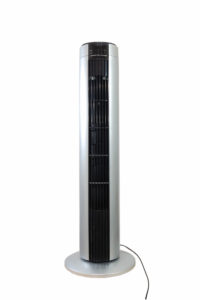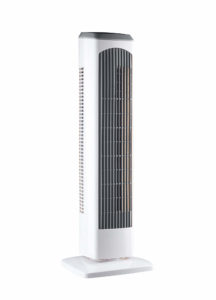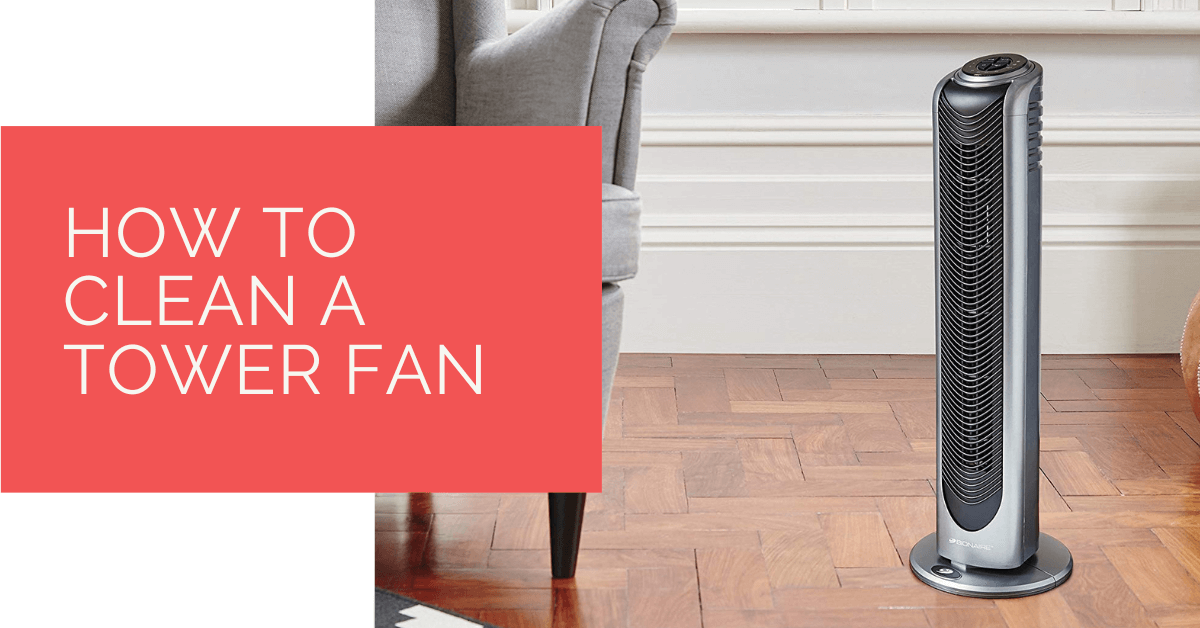Traditionally, fans cool a space by drawing air through the unit with the power of blades. The air is drawn from the back and pushed forward to create a draft.
A tower fan draws in air through side vents nestled neatly into the housing. Before being pushed through the front of the machine, the air is spun around.
To understand the workings of a tower fan better and learn how to clean it, read on ahead.
Contents
Key Takeaways
- There are different types of tower fans, including bladeless, pedestal, oscillating, and outdoor models, each with unique features and benefits.
- Cleaning a tower fan is essential to maintain its proper functioning, and it can be done by brushing off exterior vents and using compressed air to clean the inside components.
- Tower fans should be cleaned every 3-4 weeks if used frequently, with less frequent cleaning if used less often. Inspecting the fan before each season of use is also recommended.
Types of Tower Fans
There are several tower fans that you can choose from for indoor and outdoor cooling, ranging from cylinders on sticks to tall, slender tower fans that rotate on a base.
Bladeless Tower Fans
The air is blown from a ring with no external blades in this style of the tower fan. A thin, high-velocity stream of air is blown through a continuous opening across the tube or extended doughnut-shaped hole by hidden vanes in the pedestal.
Compared to a tower fan with vents, this design is appealing and easy to clean.
Pedestal Tower Fans
 These are fans with a large base mounted on a pole. They’re robust and elegant, and they only blow air from the top of the fan. This tower fan is ideal for concealing behind furniture or directing air above a bed or other platform.
These are fans with a large base mounted on a pole. They’re robust and elegant, and they only blow air from the top of the fan. This tower fan is ideal for concealing behind furniture or directing air above a bed or other platform.
Oscillating Tower Fans
Oscillating tower fans rotate back and forth, providing more comfort over a larger area than fixed fans that direct airflow to a single location.
Outdoor Tower Fans
A damp-rated or wet-rated fan is intended for use outside or in spaces where moisture can accumulate, such as restrooms or laundry rooms. Outdoor fans have a specifically built motor casing that protects the wiring and can withstand humidity.
Cleaning a Tower Fan
Tower fans can collect dust, pet hair, and other allergens, so you’ll need to clean it frequently to maintain it properly. Fortunately, they don’t require much upkeep and most fans can be cleaned simply by brushing off the outside vent and blasting it with compressed air.
If the fan still doesn’t work properly or begins to make noise, pry apart the fan’s case. To keep your home cool during summer, clean out the fan’s guts and lubricate the bearings.
However, using a microfiber towel to dust the fan’s exterior or vacuuming it isn’t adequate. You’ll also need to open the fan and clean the inside.
How Often Should a Tower Fan be Cleaned?
Fans cool you down, but when they’re clogged with dirt, they can’t circulate air adequately. Therefore, you must clean your tower fan once every 3-4 weeks. However, this may vary according to how often you use it.
In case you don’t use it too often, you may clean it once every 6-8 weeks. Additionally, you should also inspect them once at the start of a season in which you will be using it and again before putting it away during winters.
What You’ll Require
- Tools for disassembling the device such as a screwdriver
- Vacuum with a brush attachment
- Soft-bristle brush or dust brush
- Pressurised air can
- All-purpose spray cleanser
- Cloth or rag
Steps to Follow
Wait for the blades to cease moving before unplugging the fan
 Before attempting to open the fan, be sure it is turned off. The blades are razor-sharp and potentially dangerous. Wait for the fan to finish spinning.
Before attempting to open the fan, be sure it is turned off. The blades are razor-sharp and potentially dangerous. Wait for the fan to finish spinning.
Unplug the fan so it won’t turn on while you’re cleaning it and put on protective eyewear and a mask to prevent dust from going into your eyes and lungs.
Vacuum dust or other particles from the vents with a vacuum’s brush attachment before opening the fan
Hold the vacuum hose end to the vents and brush the dust into it with a dry paintbrush if you don’t have a brush attachment. Remove dust from the outside with a hoover equipped with a brush attachment. This will complete the task without damaging the casing.
Use a dust brush or a microfibre duster if you don’t have a brush attachment. Pay special attention to the vents, where the fan’s air enters and departs. The goal is to get as much dust, lint, and other material out of the way as possible.
Read manufacturer instructions
Certain specific makes of tower fans are not supposed to be opened for cleaning and may void the warranty if you do so. Therefore, before you start cleaning, check the make and model of your fan.
If to be opened, take out the screws
Locate the two to eight Philips-head screws that hold the casing to the fan’s frame, depending on the type. Unscrew them with a Philips head screwdriver of the proper size. Place the screws wherever you had found them when it’s time to reassemble the fan.
Begin prying the case from the top and work your way down with a flat head screwdriver
Be mindful that the bottom inside of the casing typically has two tabs that can break if you apply too much pressure.
Remove the front panel from the tower by sliding it up and away
After you’ve finished separating the panels, don’t take them apart immediately. The panels are held together by a couple of plastic tabs that are easily broken. Lift the front panel gently away from the remaining panels, leaving them in place.
If the tabs break, it will be significantly more difficult to reinstall the panel on the tower. So, to avoid harming the casing, work slowly.
Next, you’ll need an air compressor or compressed air can, which you can find at most home improvement stores
Position the blower nozzle and turn on the air compressor if you’re using one. You’ll find out how long to wait for the compressor to build up pressure in the instruction manual.
If you’re using pressurised air in a can, give it a good 30-second shake. Blow compressed air into the vent to remove any dirt that has become lodged. Aim it squarely at the machine’s inside, straight via the vents.
And while expelling the air, move the nozzle along with the vent and use the canister to go over the entire vent.
Also, remember to begin blowing the flat surfaces and crevices from the top of the fan and work your way down.
strong>After that, test the fan by reinstalling the components.
Make sure that the bearings and fan blades are in the proper positions. If you removed them, replace them and secure them with screws if necessary. Reattach the housing, then plug the fan in and let it run for a few minutes.
Alternative Approach
- Add two or three drops of some mild dish soap to the warm water in the sink. Fill a dish with the soap and water solution if your vent panel isn’t removable.
- Soak removable panels in soapy water for a few minutes and then wipe them clean with a soft cloth, wiping each vent and being careful not to spill water into the fan inside the non-removable panels.
- Remove the removed panel and rinse it with clear water.
- To remove the residual soap, wipe down the connected panels with a clean, wet cloth.
- Before reattaching or running the fan, wipe the panel thoroughly with a towel or let it air dry entirely.
Heat Pump Source: Reliable Heating and Cooling Solutions
At Heat Pump Source, we take pride in our unwavering commitment to serving the UK with top-tier HVAC solutions. From the efficiency of heat pumps and the cool relief of air conditioning to the warmth of boilers, radiators, and underfloor heating, our dedicated team is always at the forefront of innovation. We understand the unique needs of every household and business, and we strive to provide dependable health and cooling products and services that are tailored just for you. Ensuring your comfort and satisfaction is our utmost priority. Whether you have questions, need guidance, or require support, we’re always here to assist. Please don’t hesitate to contact us; we’re eager to be of service.
Conclusion
If you use your fan regularly, you should inspect it and clean it once a month if dust or debris has accumulated. Replace the filters in models every three months or as the manufacturer recommends.
It’s worth noting that you won’t always need to replace or clean it, but inspecting it is usually a good idea.
About the Author
At Heat Pump Source, our articles are the product of a collaborative effort among a team of highly skilled HVAC experts. Our dedicated professionals, hailing from diverse backgrounds in heating, ventilation, air conditioning, and refrigeration, contribute their extensive knowledge and experience to every piece of content. This multidisciplinary approach ensures comprehensive coverage. Our commitment is to deliver authoritative, reliable, and tailored advice to meet the unique needs of every household and business across the UK.

